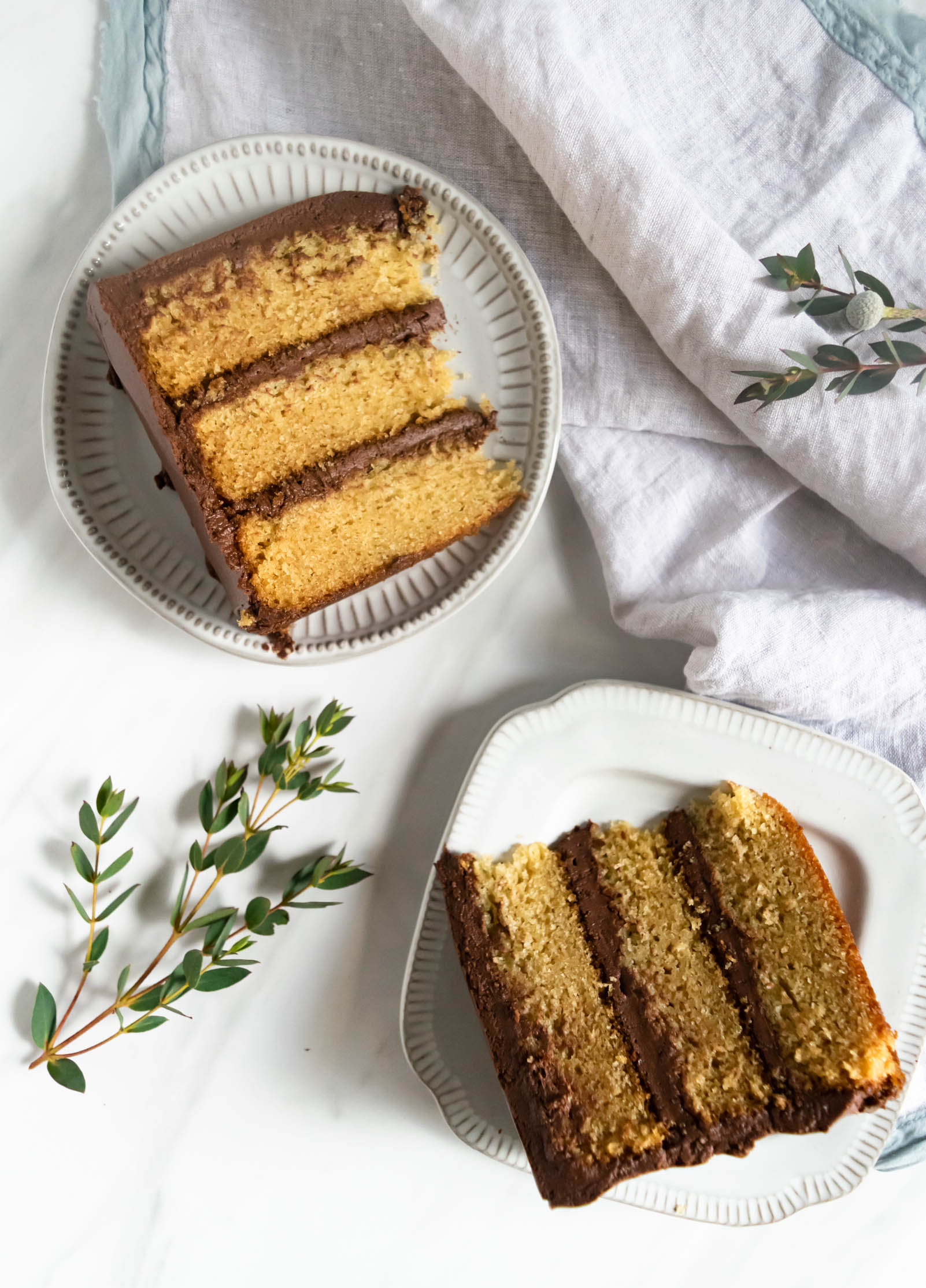Everyday Cake with Chocolate Ganache Frosting
/Good cake should not be a rarity. Everyday, no matter the challenges and struggles we might face, there are small things that should be celebrated. I think that celebrating the little things helps to keep us grounded and grateful, it helps me not get overwhelmed by the big stuff that I can’t always control. And my favorite way to celebrate is through cake! This “everyday cake” is my take on the classic yellow boxed cake, jazzed up a little.
When you think about that quintessential yellow cake, it’s marked by moistness and fluffiness (those are very technical descriptions). In order to create an extra moist cake, I used both butter and oil in this recipe. I chose to use olive oil because I wanted to give a slightly grassy and full flavor, but you can easily substitute another more neutral oil. I used a blend of cake and all purpose flour to create a fluffy cake that would still hold up under the weight of the ganache. Cake flour has a lower protein level than other flours, so it creates less gluten which results in a lighter, fluffier crumb. You could also use all cake flour for the total flour amount, or even all AP flour (just remember your cake will be a little heavier).
For this frosting, I didn’t want anything cloyingly sweet so I decided to use Rose Levy Beranbaum’s ganache frosting method and it turned out wonderfully and couldn’t be simpler. Using a food processor, pulse your chocolate to create small crumbs. Then heat heavy cream to a scald and pour into the running food processor, processing for about a minute until everything is emulsified. Then, transfer the ganache frosting to a bowl and let it cool until room temperature and slightly set up. This created a frosting that was denser than a traditional chocolate frosting, yet lighter than a ganache. Perfect for this everyday cake for all of your little celebrations!
Everyday Cake with Chocolate Ganache Frosting
Yield: 1 3-layer 8” cake
Ingredients:
for the cake:
2 1/4 cups cake flour
1 cup all purpose flour
2 tsp baking powder
1 1/2 tsp salt
1 1/2 tsp baking soda
1 1/2 cup sour cream
3/4 cup olive oil
1 tbsp vanilla extract
1 cup (2 sticks) unsalted butter, cubed, at room temperature
1 1/2 cup sugar
1/2 cup brown sugar
5 eggs
3 egg yolks
for the ganache frosting:
16 oz dark chocolate (60% cocoa)
17.6 oz heavy cream
Procedure:
to make the cake:
Preheat the oven to 350 degrees. Spray 3 8” cake pans with nonstick spray and line the bottoms with parchment paper rounds. Set aside.
In a medium bowl, whisk together cake flour, all purpose flour, baking powder, baking soda, and salt. Set aside.
In a large measuring cup or medium bowl, whisk together olive oil, sour cream, and vanilla extract. Set aside.
In the bowl of a standing mixer fitted with a paddle attachment, cream together butter and sugar until light and fluffy, about 4 minutes. Scrape down the sides of the bowl. With the mixer on low-medium speed, add eggs, one at time, making sure they are thoroughly combined before adding the next. Remember to scrape down the bottom and sides of the bowl frequently to make sure that everything is being evenly combined.
Reduce mixer speed to low and add 1/3 of the dry ingredients. Just before it is completely combined, add in half of the sour cream mixture. Alternate with another third of the dry ingredients, followed by the remaining half of the sour cream mixture. Finish by adding the final third of the dry ingredients and mix until everything is well combined.
Evenly divide batter among the three prepared pans and bake, rotating halfway through if necessary, for 25-30 minutes, until the cake begins to pull away from the sides of the pan springs back when touched.
Let cool for 5-10 minutes in the pan and then turn them out onto a cooling rack and let rest until complete cooled.
to make the ganache frosting:
When you are ready to frost the cake, place chocolate pieces in the bowl of a food processor. Pulse until chocolate is broken up into very small pieces.
Heat the cream in a medium saucepan until just before simmering, and small bubbles begin to appear on the outer edges. Very carefully, pour in the cream into the running food processor through the feed tube and continue processing for about 30 seconds after adding the last of the cream, until everything is combined. Transfer the ganache to a bowl and let sit at room temperature for a couple of hours, until completely cooled and thickened.
Just before you frost the cake, if you want your ganache a little thicker and fluffier, you can beat it in the stand mixer for a minute or two until it reaches your desired consistency. Be careful not to beat it too much, or too much air will be incorporated and your frosting will have air bubbles and won’t smooth completely when frosting.
to assemble the cake:





